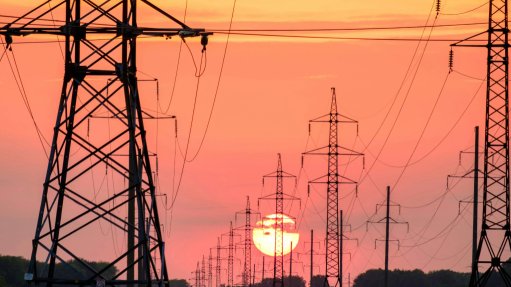Noncarbon future epitomises ideal energy mix


JAMES TRUDEAU It is “very critical” that Eskom increases its energy storage capacities to support a more diversified energy portfolio
In about 2060, the ideal energy mix would be one with only noncarbon sources, such as wind, solar, pumped hydro and hydrogen, says leading global safety science company UL.
“In the practical world that connects today to tomorrow, South Africa will have to slowly replace more than 45 000 MW of carbon-based thermal generation with noncarbon generation sources,” notes James Trudeau, the global business development manager for energy systems and e-mobility at UL’s energy and power technology division.
Currently, only 9% of South Africa’s electricity is derived from the aforementioned noncarbon sources.
He adds that a lot of energy storage will be needed to successfully blend these new energy sources into State-owned power utility Eskom’s grid.
Trudeau tells Engineering News that it is “critical” that the utility increases its energy storage capacities to support a more diversified energy portfolio, as this will allow for three main things to happen.
Firstly, it would allow for an increase in the adoption of variable resources – such as wind and solar – by storing and shifting energy to more desired times.
He enthuses that the vast decrease in the price of solar over the past ten years – especially considering South Africa’s significant sun potential – bodes well for Eskom and the country in this regard.
Secondly, it would defer expensive capital projects to upgrade distribution lines.
Thirdly, it will improve grid support capabilities, such as frequency and voltage support, in support of renewable energy.
“Eskom is already working with the Electric Power Research Institute to increase and improve the use of energy storage in its distribution system. While it could be beneficial for Eskom to speed up the adoption of energy storage, the ‘real-world difficulties’ of available capital and limited engineering resources limit Eskom’s ability to do so,” he underscores.
Trudeau advances that the three key drivers for a more rigorous renewable-energy uptake could be the comparative cost of energy between traditional thermal generation and noncarbon generation, government requirements for the use of renewable energy, and customer desire to use renewable energy.
Further, he highlights that the most important factor for utilities to be aware of when awarding projects of this nature to companies in the energy storage sector,
is the difference between partial and truly complete services.
For example, large batteries present unique safety considerations, because they contain high levels of energy and may make use of hazardous materials and moving parts.
UL works hand in hand with system integrators and original-equipment manufacturers to better understand and address these issues.
With 200 UL staff in the company’s energy storage systems research and development department, Trudeau advances that the company is at the forefront of understanding health and safety in the various sectors in which it operates.
“We can help Eskom and regulatory authorities in South Africa to develop and adopt or adapt codes and standards that will ensure that energy storage is used in a way that is efficient, safe and environment-friendly. “UL desires to be the premier provider of due diligence, independent engineering, and programme management services to energy storage system developers, lenders, municipalities and the national utility, Eskom.”
Moreover, he tells Engineering News that the company is developing new codes and standards for emerging energy storage technologies such as flow batteries, hydrogen, and metal/air batteries to support these aspirations.
UL’s footprint spans countries such as the US, Korea, Germany, Canada, China, Burkina Faso, Mali as well as the Middle East region.
Article Enquiry
Email Article
Save Article
Feedback
To advertise email advertising@creamermedia.co.za or click here
Comments
Press Office
Announcements
What's On
Subscribe to improve your user experience...
Option 1 (equivalent of R125 a month):
Receive a weekly copy of Creamer Media's Engineering News & Mining Weekly magazine
(print copy for those in South Africa and e-magazine for those outside of South Africa)
Receive daily email newsletters
Access to full search results
Access archive of magazine back copies
Access to Projects in Progress
Access to ONE Research Report of your choice in PDF format
Option 2 (equivalent of R375 a month):
All benefits from Option 1
PLUS
Access to Creamer Media's Research Channel Africa for ALL Research Reports, in PDF format, on various industrial and mining sectors
including Electricity; Water; Energy Transition; Hydrogen; Roads, Rail and Ports; Coal; Gold; Platinum; Battery Metals; etc.
Already a subscriber?
Forgotten your password?
Receive weekly copy of Creamer Media's Engineering News & Mining Weekly magazine (print copy for those in South Africa and e-magazine for those outside of South Africa)
➕
Recieve daily email newsletters
➕
Access to full search results
➕
Access archive of magazine back copies
➕
Access to Projects in Progress
➕
Access to ONE Research Report of your choice in PDF format
RESEARCH CHANNEL AFRICA
R4500 (equivalent of R375 a month)
SUBSCRIBEAll benefits from Option 1
➕
Access to Creamer Media's Research Channel Africa for ALL Research Reports on various industrial and mining sectors, in PDF format, including on:
Electricity
➕
Water
➕
Energy Transition
➕
Hydrogen
➕
Roads, Rail and Ports
➕
Coal
➕
Gold
➕
Platinum
➕
Battery Metals
➕
etc.
Receive all benefits from Option 1 or Option 2 delivered to numerous people at your company
➕
Multiple User names and Passwords for simultaneous log-ins
➕
Intranet integration access to all in your organisation



















